If you’re looking to create your own slice of tranquility at home, Japanese gardens offer stunning inspiration. With a variety of styles and elements, these gardens blend nature and design seamlessly. Whether you’re working with a small balcony or a spacious backyard, you’ll find fresh ideas to enhance your outdoor space and bring a touch of Zen to your life.
Bamboo Fences and Screens
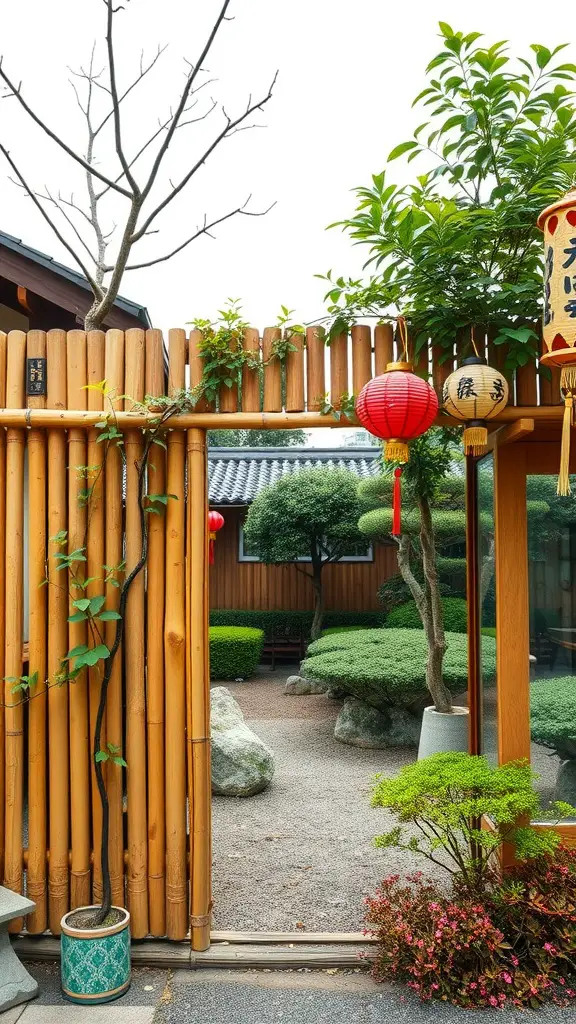
Bamboo fences and screens are a classic element in Japanese gardens. They create a natural barrier while adding a touch of elegance. The image showcases a beautifully crafted bamboo fence that frames a serene garden space.
The warm tones of the bamboo contrast nicely with the lush greenery. Lanterns hanging nearby add a pop of color and charm. This setup not only provides privacy but also enhances the overall aesthetic of the garden.
Incorporating bamboo elements can transform your outdoor space. They are versatile and can be used in various ways, from simple fences to intricate screens. This creates a peaceful retreat that invites relaxation and contemplation.
Zen Rock Gardens

Zen rock gardens, or karesansui, are a beautiful way to bring tranquility to your outdoor space. These gardens use rocks, gravel, and minimal plants to create a serene atmosphere. The image shows a stunning arrangement of various stones, with some greenery peeking through. This simple yet elegant design invites calmness and reflection.
The rocks are carefully placed to represent mountains or islands, while the raked gravel mimics water ripples. This design encourages mindfulness and meditation, making it a perfect spot for relaxation. You can easily create your own Zen rock garden by choosing a few stones and arranging them in a way that feels right to you.
Adding small plants, like the palm in the image, can enhance the natural feel of the garden. Remember, the key is simplicity. The fewer elements you have, the more peaceful the space will feel. So grab some rocks and start designing your own little oasis!
Stone Lanterns and Pathways
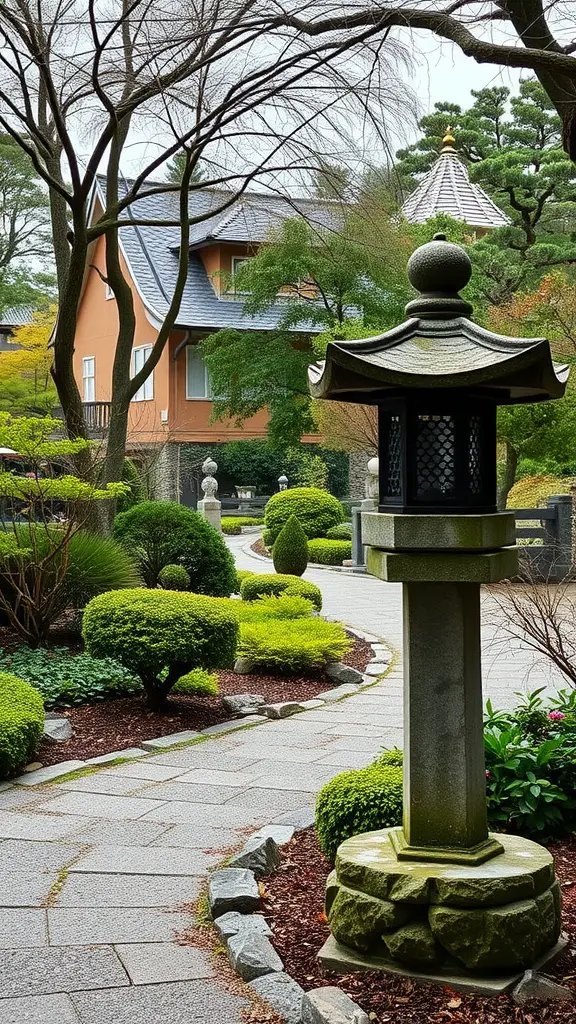
Stone lanterns are a classic feature in Japanese gardens. They add a touch of tradition and charm. These lanterns often serve both a practical and aesthetic purpose. They light up pathways during the evening, creating a serene atmosphere.
The image shows a beautifully crafted stone lantern standing proudly along a winding path. The path is made of smooth stones, inviting visitors to stroll through the garden. Lush greenery surrounds the path, with neatly trimmed bushes and trees that enhance the natural beauty.
Pathways in Japanese gardens are designed to guide visitors. They encourage exploration and contemplation. The gentle curves of the path create a sense of flow, making the garden feel more expansive. Each turn reveals new sights and experiences, keeping the journey engaging.
Combining stone lanterns with thoughtfully designed pathways can transform your garden into a peaceful retreat. These elements work together to create a harmonious space where nature and design coexist beautifully.
Tea House Retreats
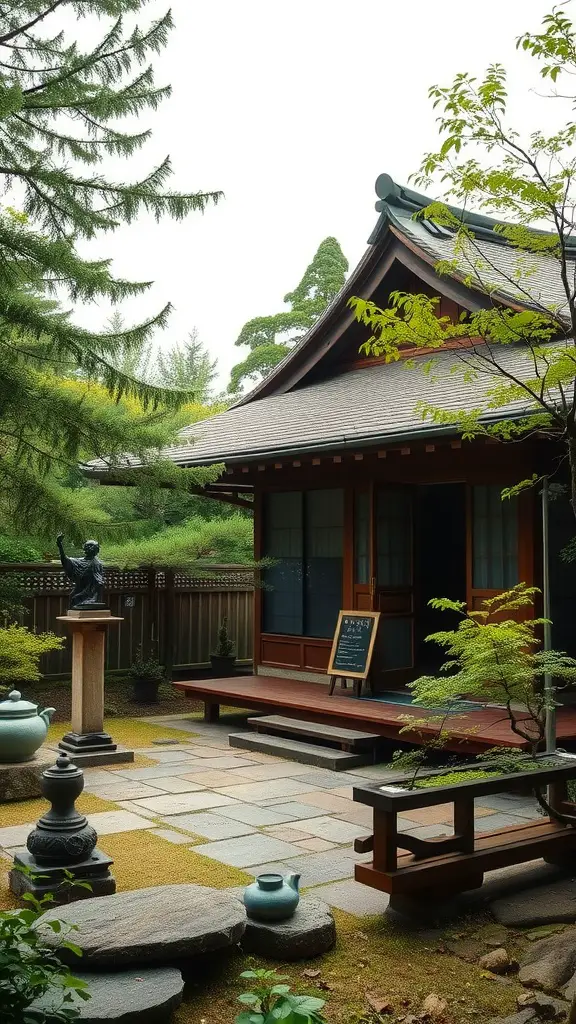
Tea houses are a lovely addition to any Japanese garden. They offer a peaceful spot to enjoy tea and reflect on nature. The image shows a charming tea house surrounded by greenery, creating a serene atmosphere.
The wooden structure blends beautifully with the landscape. Its traditional design features a sloping roof and large windows, inviting natural light inside. The stone pathway leads to the entrance, enhancing the connection to the garden.
In front of the tea house, you can see decorative elements like stone lanterns and a small statue. These details add character and charm to the space. The carefully arranged plants and moss create a calming environment, perfect for relaxation.
Creating your own tea house retreat can be a rewarding project. Consider using natural materials and incorporating elements like a small pond or rock garden. This will help you achieve that authentic Japanese garden feel.
Gravel and Sand Patterns
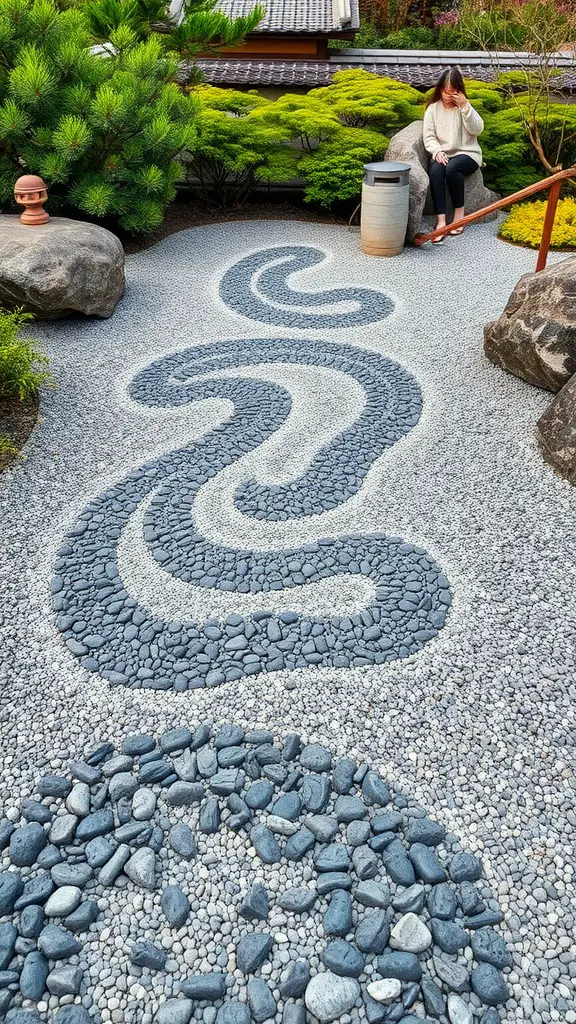
Gravel and sand patterns are a key feature in Japanese gardens, adding both beauty and tranquility. The image shows a serene pathway made of carefully arranged stones and pebbles, creating flowing designs that mimic natural water patterns.
The winding lines and circular shapes invite visitors to explore the garden. This design not only looks appealing but also encourages mindfulness as one walks along the path. The contrast between the smooth stones and the surrounding greenery enhances the overall aesthetic.
Incorporating gravel and sand patterns into your garden can transform it into a peaceful retreat. You can play with different shapes and colors to match your style. Whether you prefer simple lines or intricate designs, these patterns can bring a unique touch to your outdoor space.
Japanese Maples
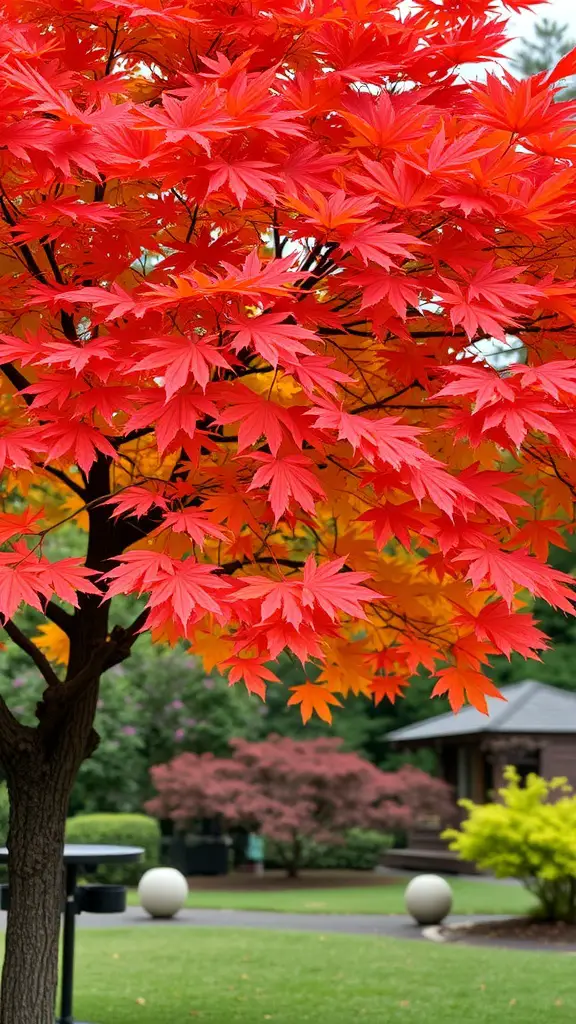
Japanese maples are a stunning addition to any garden. Their vibrant leaves can bring a splash of color, especially in the fall. The image shows a beautiful tree with bright red and orange leaves, creating a striking contrast against the green backdrop.
These trees are known for their delicate, finely cut leaves. They can grow in various sizes, making them suitable for small gardens or larger landscapes. When placed strategically, they can serve as focal points or provide shade.
Incorporating Japanese maples into your garden design can create a serene atmosphere. They thrive in well-drained soil and prefer partial shade, making them perfect for creating a peaceful retreat. Whether you choose a single tree or a cluster, their beauty is sure to enhance your outdoor space.
Koi Ponds and Water Features
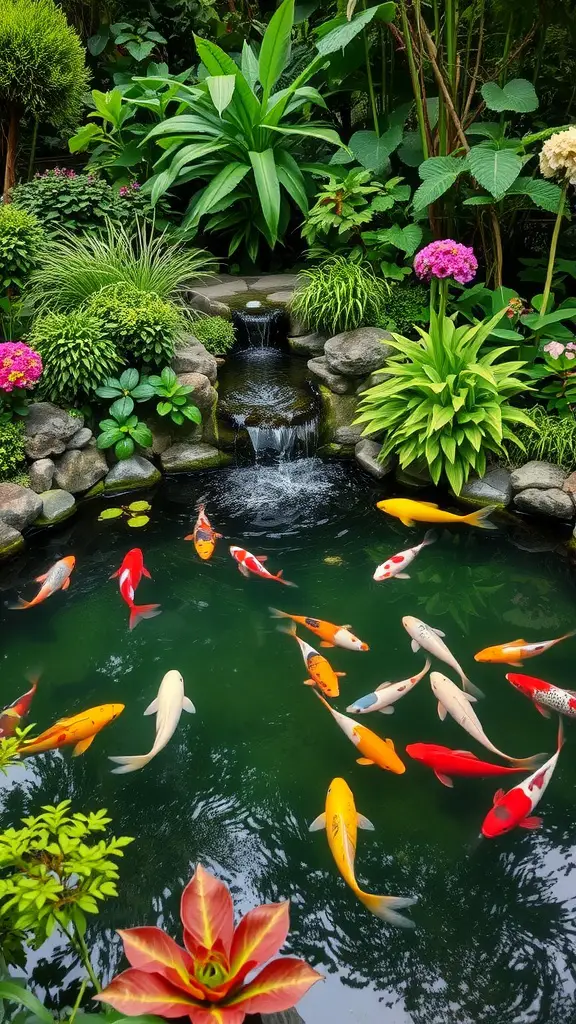
Koi ponds are a stunning addition to any Japanese garden. They bring life and movement, creating a serene atmosphere. In the image, colorful koi fish swim gracefully in a lush, green setting. The vibrant reds, yellows, and whites of the fish contrast beautifully with the dark water.
Water features like this pond are not just for looks; they also provide a habitat for koi and other aquatic plants. The gentle sound of water flowing from the small waterfall adds to the peaceful vibe. Surrounding plants, such as ferns and flowers, enhance the natural beauty.
Creating a koi pond can be a rewarding project. It involves selecting the right location, ensuring proper filtration, and choosing plants that thrive in aquatic environments. With some planning, you can enjoy the tranquility that a koi pond brings to your garden.
Cherry Blossom Trees
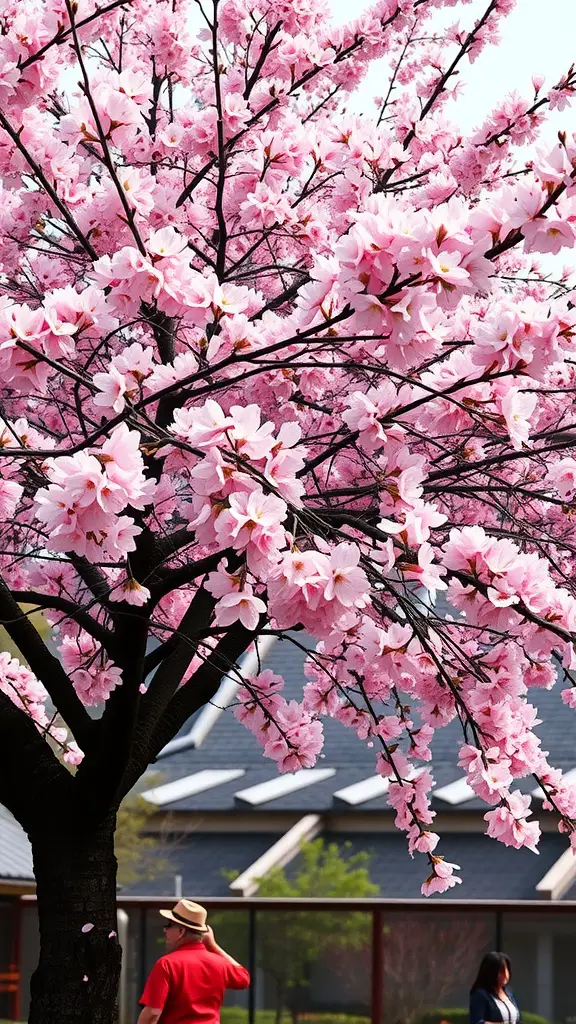
Cherry blossom trees are a stunning addition to any Japanese garden. Their delicate pink flowers create a beautiful display that captures the essence of spring. These trees are not just visually appealing; they also symbolize renewal and the fleeting nature of life.
In the image, you can see a vibrant cherry blossom tree, full of blossoms that seem to dance in the breeze. The contrast of the pink flowers against the dark branches is striking. This creates a lovely focal point in any garden setting.
Cherry blossoms are often celebrated during hanami, a traditional Japanese practice of enjoying the beauty of these blooms. People gather under the trees to appreciate their beauty, share food, and enjoy each other’s company. Incorporating cherry blossom trees into your garden can create a space for relaxation and reflection.
When planning your garden, consider the placement of these trees. They thrive in well-drained soil and need plenty of sunlight. With proper care, they can flourish and provide a stunning display year after year.
Stone Paths and Bridges
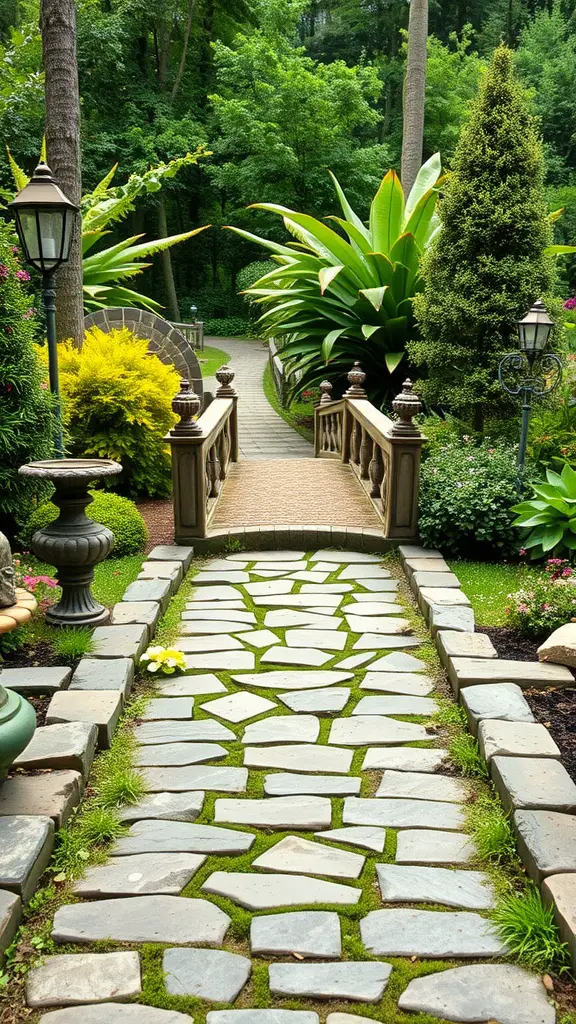
Stone paths and bridges are key elements in Japanese gardens. They guide visitors through the landscape, creating a sense of journey and exploration. The image shows a beautiful stone path lined with greenery, leading to a charming bridge. This setup invites you to walk and enjoy the surroundings.
The path is made of flat stones, with patches of moss peeking through. This natural look blends perfectly with the vibrant plants on either side. The bridge adds a lovely touch, making it a perfect spot for photos or quiet reflection.
Incorporating stone paths and bridges in your garden can enhance its beauty and functionality. They not only connect different areas but also create visual interest. Whether you choose a simple design or something more intricate, these features can transform your garden into a serene retreat.
Waterfall Gardens
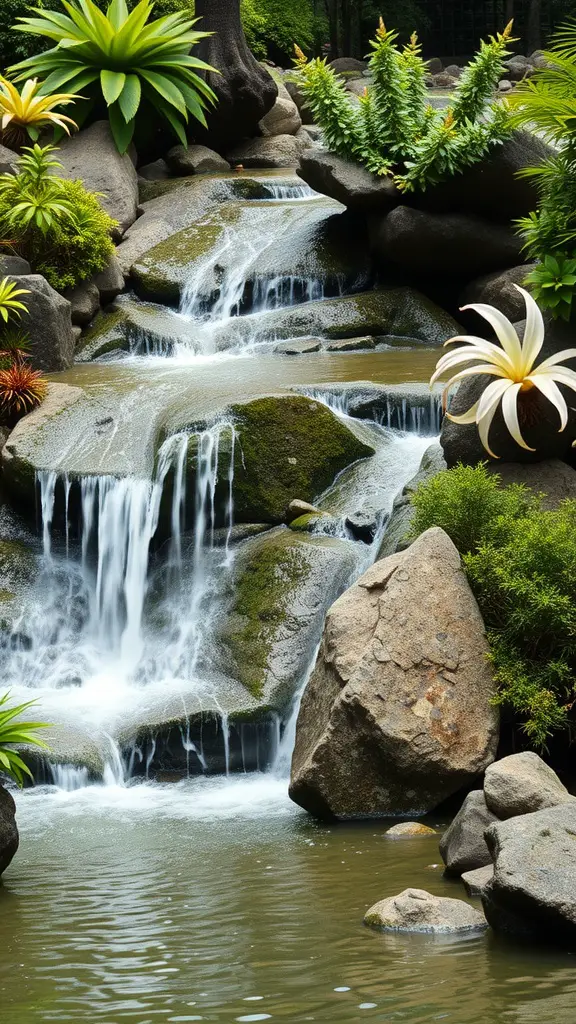
Waterfall gardens bring a sense of tranquility and beauty to any outdoor space. The image showcases a stunning waterfall cascading over smooth rocks, creating a serene atmosphere. The gentle flow of water is soothing and can be a focal point in your garden.
Surrounding the waterfall are lush green plants that add life and color. The combination of water and greenery creates a peaceful retreat. You can imagine sitting nearby, listening to the water while enjoying a cup of tea or reading a book.
Incorporating a waterfall into your garden design can enhance the overall aesthetic. It can attract birds and other wildlife, turning your garden into a lively ecosystem. Whether you opt for a small trickle or a grand cascade, a waterfall garden can transform your outdoor space into a haven of relaxation.
Floating Islands in Ponds
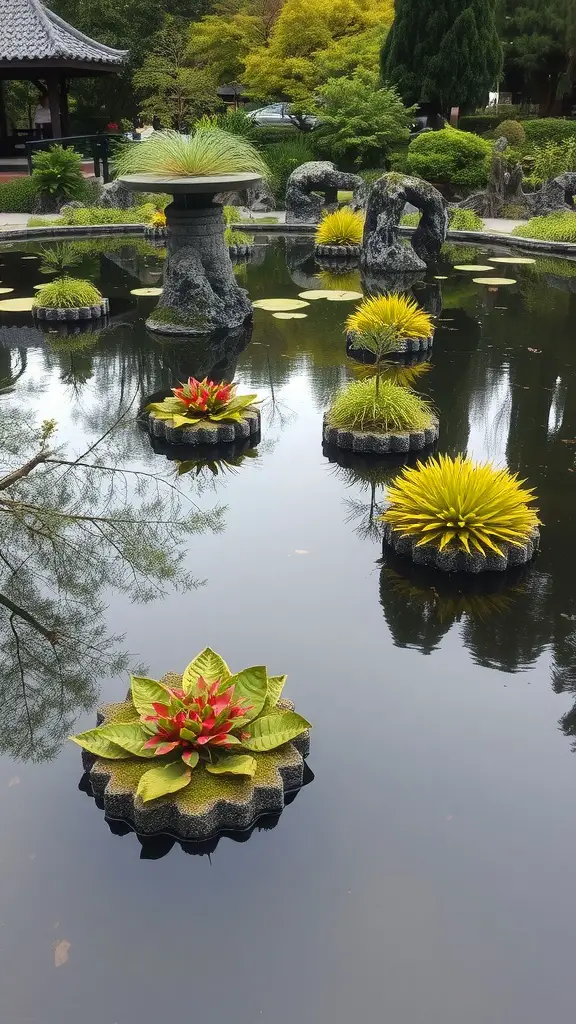
Floating islands in ponds add a unique charm to Japanese gardens. These islands often feature vibrant plants that seem to dance on the water’s surface. In the image, you can see several beautifully arranged floating islands, each showcasing a mix of colors and textures.
The bright yellow and pink plants create a striking contrast against the dark water. This design not only enhances the visual appeal but also promotes a sense of tranquility. The use of natural elements like rocks and water reflects the harmony often found in Japanese garden design.
These floating islands can serve multiple purposes. They provide habitats for wildlife and can even help with water filtration. If you’re looking to create a similar feature in your garden, consider using native aquatic plants that thrive in your climate.
Overall, floating islands are a fantastic way to bring life and color to your garden pond. They invite visitors to pause and appreciate the beauty of nature.
Seasonal Plantings
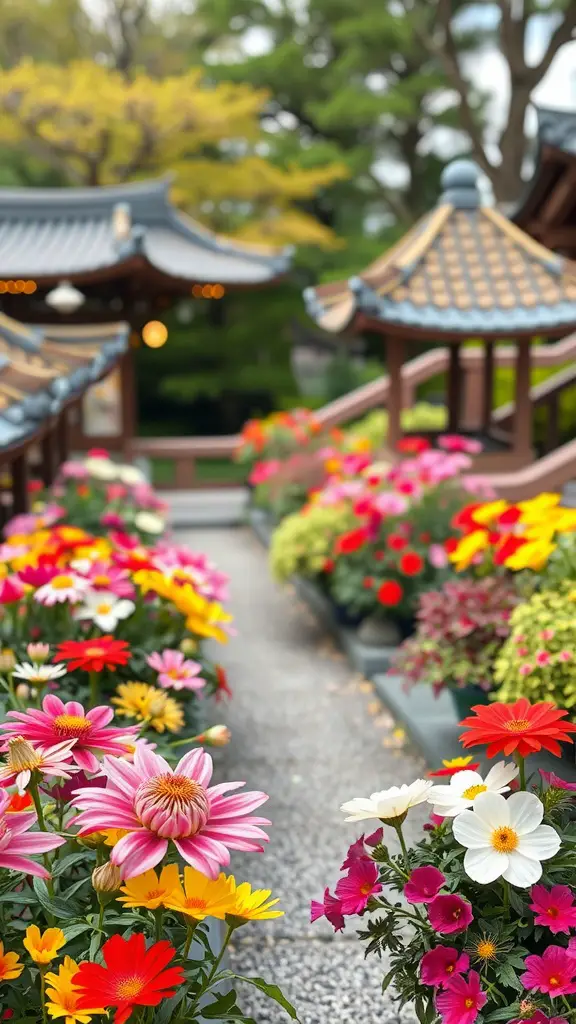
Seasonal plantings bring a lively touch to Japanese gardens. The image showcases a stunning pathway lined with vibrant flowers, creating a cheerful atmosphere. Bright reds, yellows, and pinks pop against the serene backdrop of traditional architecture.
In spring, flowers like cherry blossoms and azaleas bloom, offering a burst of color. Summer brings sunflowers and lilies, while autumn showcases the rich hues of chrysanthemums and maples. Each season offers unique plants that enhance the garden’s beauty.
Choosing the right flowers for each season not only adds visual interest but also supports local wildlife. Bees and butterflies are drawn to the blooms, creating a lively ecosystem. This connection to nature is a key element in Japanese garden design.
Consider planting a mix of perennials and annuals for continuous blooms. This approach ensures that your garden remains vibrant throughout the year. With careful planning, you can create a seasonal display that delights the senses and invites visitors to explore.
Moss Gardens
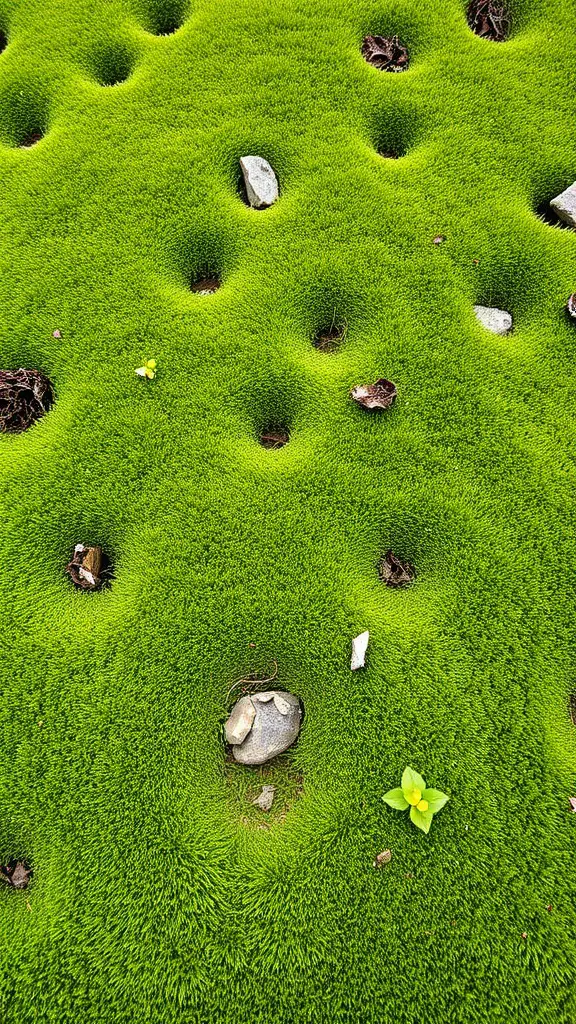
Moss gardens are a beautiful way to bring a touch of nature into your space. The image shows a vibrant green moss carpet, dotted with small stones and delicate flowers. This lush greenery creates a serene atmosphere, perfect for relaxation.
Moss is low-maintenance and thrives in shady areas, making it an ideal choice for gardens that don’t get much sunlight. The texture of the moss adds depth and interest, while the stones provide a natural contrast. You can use different types of moss to create patterns or designs, enhancing the visual appeal.
Incorporating moss into your garden can also support local wildlife. It provides a habitat for small creatures and helps retain moisture in the soil. Consider adding a few stepping stones or paths to guide visitors through your moss garden, allowing them to appreciate its beauty up close.
Garden Statues and Ornaments
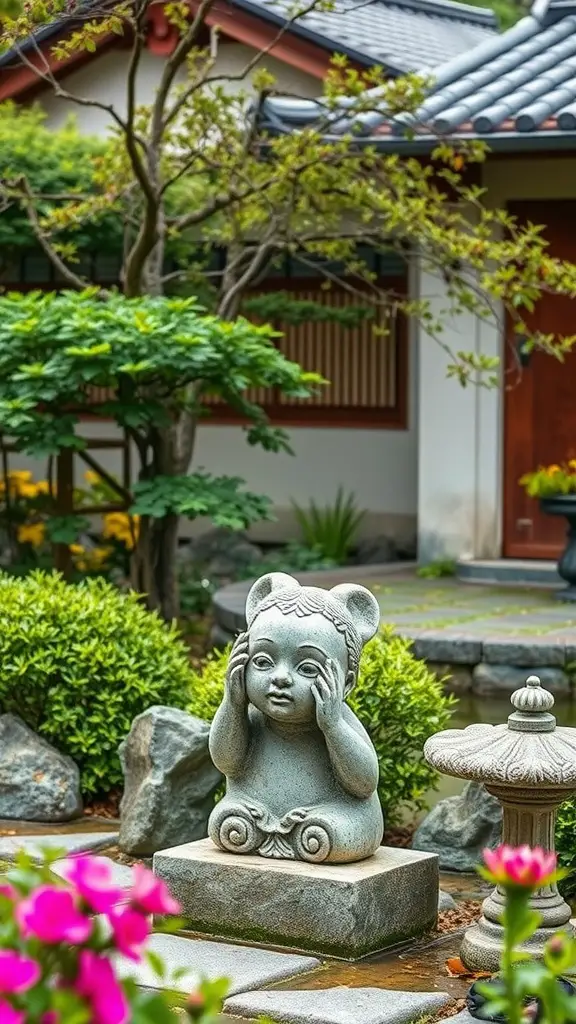
Garden statues and ornaments add a unique charm to Japanese gardens. They serve as focal points that draw the eye and create a sense of peace. In this image, a delightful stone statue of a child with bear ears captures attention. Its playful expression brings a lighthearted touch to the serene surroundings.
Surrounded by lush greenery and colorful flowers, the statue fits perfectly into the garden’s natural beauty. The soft contours and gentle features of the statue contrast nicely with the sharp lines of the rocks and the structured elements of the garden. This combination creates a balanced look that is pleasing to the eye.
Ornaments like this can tell a story or represent cultural symbols, making them meaningful additions. Whether it’s a whimsical figure or a traditional piece, each statue adds personality to the garden. They invite visitors to pause and reflect, enhancing the overall experience of the space.
Sculptural Pruned Trees
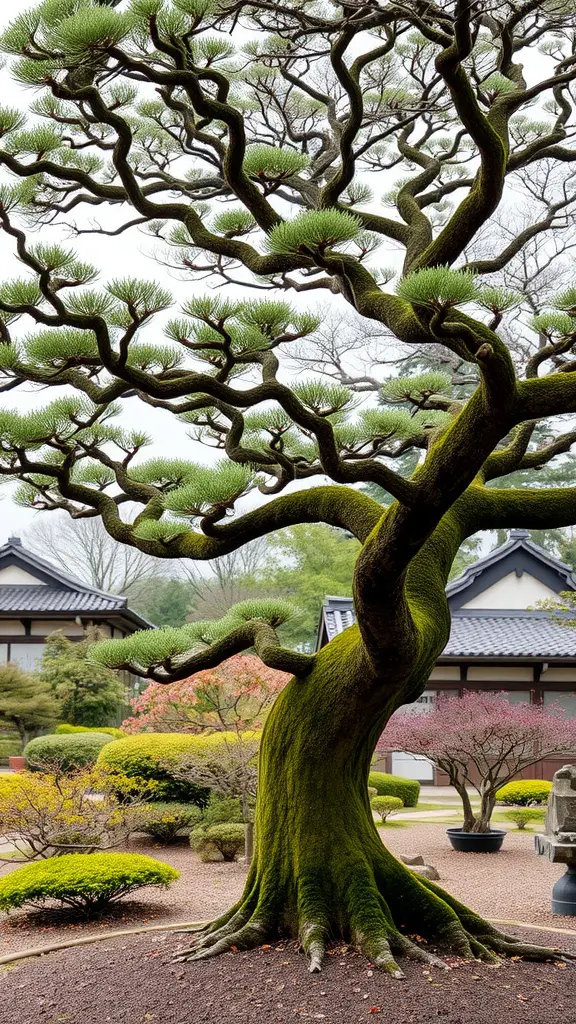
Sculptural pruned trees are a stunning feature in Japanese gardens. They showcase the beauty of nature while reflecting the art of careful design. The image captures a beautifully shaped tree, with its branches elegantly reaching out. The lush green needles contrast with the dark, textured bark, creating a striking visual.
These trees often symbolize strength and resilience. Their unique shapes are achieved through meticulous pruning techniques, which have been passed down through generations. Each twist and turn of the branches tells a story, inviting visitors to appreciate the artistry involved.
Incorporating sculptural trees into your garden can add character and depth. They serve as focal points, drawing the eye and sparking conversation. Whether you choose a pine, maple, or another variety, these trees can transform your outdoor space into a serene retreat.
Ornamental Grasses
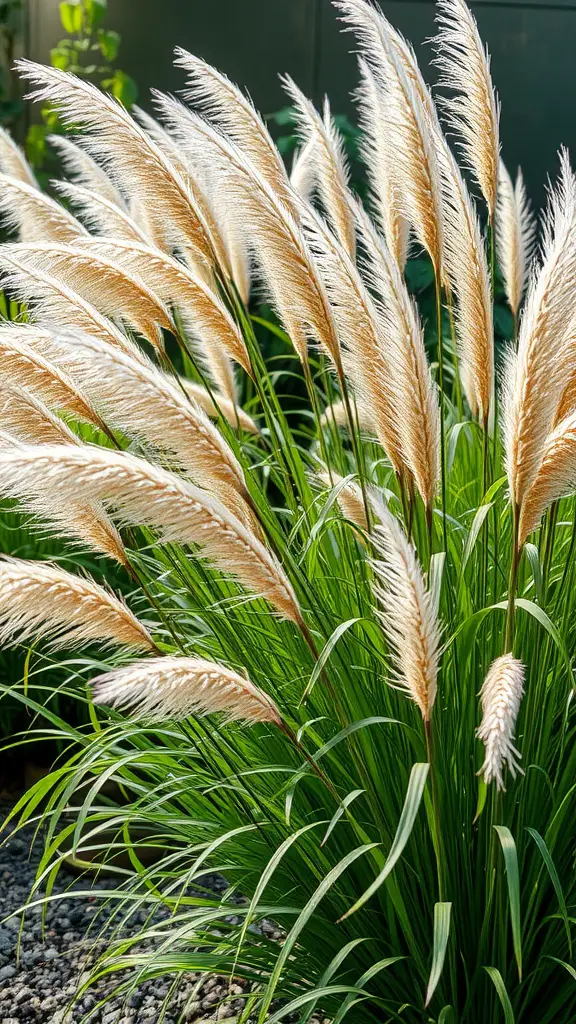
Ornamental grasses are a fantastic addition to any Japanese garden. They bring texture and movement, creating a serene atmosphere. The image shows beautiful pampas grass, with its feathery plumes swaying gently in the breeze.
These grasses can be used in various ways. They can act as borders, fill empty spaces, or even serve as focal points. The soft colors and delicate shapes of the grass contrast nicely with more rigid elements like rocks and water features.
When choosing ornamental grasses, consider their height and growth habits. Some varieties can grow quite tall, while others stay low and compact. This variety allows for creative landscaping options.
Incorporating ornamental grasses into your garden design can enhance the overall look and feel. They not only add beauty but also attract wildlife, making your garden a lively spot.




